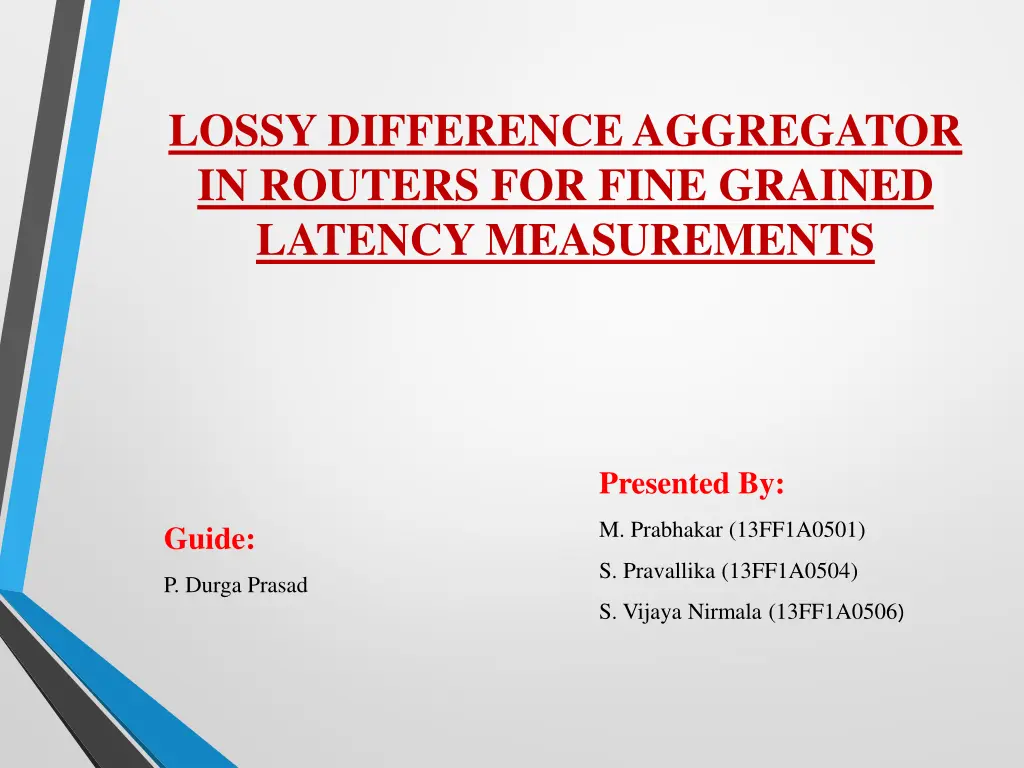
Lossy Difference Aggregator in Routers for Fine-Grained Latency Measurements
Explore a novel approach, Lossy Difference Aggregator (LDA), for measuring fine-grained latencies in datacenter network applications. This solution enhances the capabilities of existing technologies like SNMP and NetFlow by offering a low-overhead mechanism for accurate latency measurements within routers, catering to the demands of latency-sensitive applications.
Download Presentation

Please find below an Image/Link to download the presentation.
The content on the website is provided AS IS for your information and personal use only. It may not be sold, licensed, or shared on other websites without obtaining consent from the author. If you encounter any issues during the download, it is possible that the publisher has removed the file from their server.
You are allowed to download the files provided on this website for personal or commercial use, subject to the condition that they are used lawfully. All files are the property of their respective owners.
The content on the website is provided AS IS for your information and personal use only. It may not be sold, licensed, or shared on other websites without obtaining consent from the author.
E N D
Presentation Transcript
LOSSY DIFFERENCE AGGREGATOR IN ROUTERS FOR FINE GRAINED LATENCY MEASUREMENTS Presented By: M. Prabhakar (13FF1A0501) Guide: S. Pravallika (13FF1A0504) P. Durga Prasad S. Vijaya Nirmala (13FF1A0506)
CONTENTS ABSTRACT INTRODUCTION EXISTING SYSTEM PROPOSED SYSTEM SYSTEM REQUIREMENTS MODULE DESCRIPTION SYSTEM DESIGN SYSTEM TESTING SCREENSHOTS CONCLUSION REFERENCES
ABSTRACT An increasing number of datacenter network applications, have stringent end-to-end latency requirements. The fine-grained measurement demands cannot be met effectively by existing technologies, such as SNMP, NetFlow, or active probing. We propose instrumenting routers with a hash-based primitive that we call a Lossy Difference Aggregator (LDA) to measure latencies.
INTRODUCTION An increasing number of datacenter-based applications require end-to-end latencies on the order of milliseconds or even microseconds. These applications range from storage-area networks (SANs) to interactive Web services that depend on large numbers of back- end services to niche but commercially important markets like automated trading and high-performance computing Currently, most of these latency-sensitive applications are deployed on specialized and technologies like InfiniBand and FibreChannel often boutique hardware
EXISTING SYSTEM An increasing number of datacenter-based applications require end-to-end latencies on the order of milliseconds or even microseconds. Moreover, many of them further demand that latency remain stable These applications range from storage-area networks (SANs) to interactive Web services that depend on large numbers of back- end services.
PROPOSED SYSTEM We propose the Lossy Difference Aggregator (LDA), a low- overhead mechanism for fine-grain latency and loss measurement that can be cheaply incorporated within routers to achieve the same effect. LDA forms the key building block of a network-wide architecture we propose for collecting fine-grained latency measurements called MPLANE LDAhas the following features: 1. Fine-granularity measurement 2. Low overhead 3. Customizability
HARDWARE REQUIREMENTS SYSTEM HARD DISK MONITOR MOUSE RAM KEYBOARD : Pentium IV 2.4 GHz : 40 GB : 15 VGA colour : Logitech. : 256 MB : 110 keys enhanced.
SOFTWARE REQUIREMENTS Operating system : Windows XP Front End : JAVA,Swing Tool : ECLIPSE
MODULES: Coordinated Streaming Internal Measurements Segmented Measurement LDA
COORDINATED STREAMING We measure the goodness of a measurement scheme by its accuracy for each. A solution to the measurement problem is for the sender to store a hash and timestamp of each sent packet and for the receiver to do the same for each received packet. At the end of the interval, the sender sends the hashes and timestamps for all packets to the receiver, who then matches the send and receive timestamps of successfully received packets using the packet hashes and computes the average.
INTERNAL MEASUREMENTS In many real routers, forwarding metrics (e.g., loss, delay) depend on the forwarding class more than the particular flow. For example, all flows traveling between the same input and output ports of a router in a given QoS class are often treated identically in terms of queuing and switch scheduling. Thus, we group such flows into what we call a measurement equivalence class (MEC).
SEGMENTED MEASUREMENT The majority of operators today employ active measurement techniques that inject synthetic probe traffic into their network to measure loss and latency on an end-to-end basis. While these tools are based on sound statistical foundations, active measurement approaches are inherently.
LDA A Lossy Difference Aggregator is a measurement data structure that supports efficiently measuring the average delay and standard deviation of delay. Both sender and receiver maintain an LDA; at the end of a measurement period in our experiments, we consider 1 s the sender sends its LDA to the receiver and the receiver computes the desired statistics.
SYSTEM DESIGN UML Diagrams: Data flow diagram Use case diagram Class diagram Activity diagram
SYSTEM TESTING The purpose of testing is to discover errors. There are various types of test. Each test type addresses a specific testing requirement. Types of testing: Unit Testing Integration Testing Functional Testing System Testing White Box Testing Black Box Testing
CONCLUSION This paper proposes a mechanism that vendors can embed directly in routers to cheaply provide fine-grain delay and loss measurement. Starting from the simple idea of keeping a sum of sent timestamps and a sum of receive timestamps that is not resilient to loss. Furthermore, it is unlikely that LDA will be deployed at all links along many paths in the near future. Moreover, if an end-to-end probe detects a problem, a manager can use the LDA mechanism on routers along the path to better localize the problem.
REFERENCE: Ramana Rao Kompella, Kirill Levchenko, Alex C. Snoeren, and George Varghese, Router Support for Fine-Grained Latency Measurements , IEEE/ACM NETWORKING, VOL. 20, NO. 3, JUNE 2012. TRANSACTIONS ON Cisco, Cisco extends highly secure, improved communications in rugged environments with new family of industrial Ethernet switches, 2007[Online]. Available: http://newsroom.cisco.com/dlls/2007/prod_111407.html Corvil, Ltd., Corvil, Ltd., 2011 [Online]. Available: http://www. corvil.com
